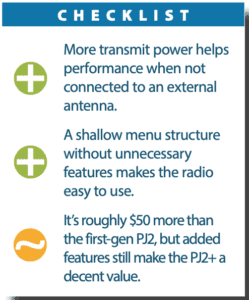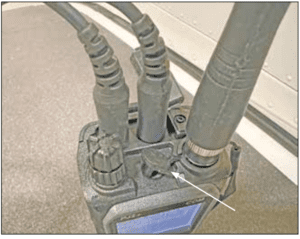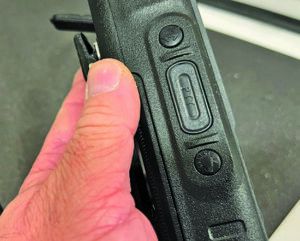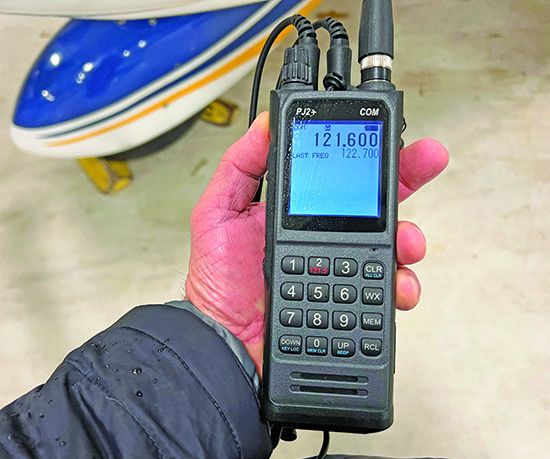Priced at $250, the latest PJ2+ transceiver attempts to improve upon what we thought was an already good product. The several first-gen PJ2s that have been serving hard duty in Aviation Consumer’s long-term test pool keep on working (see the report in our March 2021 issue).
As a follow-on, Sporty’s has done what we would expect, flying with the radio and collecting data from other users for an improved PJ2+ model, made by Japanese Rexon. We’ve been passing around a few new demo units, and here’s a report.
POWER, DISPLAY BOOST
Those are words we like hearing about any portable rig, especially when using them with portable rubber antennas in sun-splashed cabins. Portable transmitters are limited by regulation to 6 watts, and the PJ2+ got a one-watt boost to the max from the old 5 watts in the PJ2. As we would find out in the air, the extra watt makes a difference.

We tried the PJ2+ in a few low-wing aircraft, including a Cirrus and Piper Archer. Unless using an external antenna, the radio needs to be held (or permanently positioned) so that there is a line of sight between it and the receiving station. In other words, transmit through the aircraft’s transparency, not the aluminum skin. On the ground, we had no problem talking with ground controllers even when tucked behind a set of hangars a few thousand feet away.
In the air and in the climb (a couple thousand feet), we tuned the receiver to an ATIS broadcast that was roughly 12 miles away and the reception was loud and clear, and it had the same performance receiving the control tower’s transmissions. Transmitting from a 10-mile range to the tower, we were told the transmissions from the PJ2+ were a bit weak and scratchy, but still readable. Worth noting is that we used a combination of headsets with the radio—from a passive David Clark to a Bose A20—and found the phone audio to be quite good. At close range and at low altitude when flying inbound for landing, the radio worked fine at all the airports we used it at.
Our sense is the extra power in the PJ2+ does boost performance and as long as there are no terrain obstructions, and when positioned properly, the PJ2+ should transmit at least 10 miles without an external antenna, or when using the supplied flexible “duck” antenna. Still, if the radio will be used as a primary (or if you plan to use it as an IFR backup while enroute), we would use an external antenna.
If we had a nit to pick (and it’s a minor one), we wish the radio’s push-to-talk switch was easier to feel—especially while wearing gloves. On the other hand, the switch being mostly flush with the side of the chassis is a good backstop for inadvertently keying the transmitter—something that’s easy to do with a portable radio. The radio does a have a key lock.
We like the LCD display on the PJ2+, and it’s a better performer than the original. It has a higher contrast making it easier to see in sunlight, but it also does a good job of cutting glare. The viewing angle is wider, too, so if you plan to mount it someplace in the cockpit you have more options. Its display has a night mode, high and low backlight adjustment and you can tweak the LCD’s contrast. To save battery life, you can deactivate the screen and keypad backlighting.
BATTERY PACK, EXPERNAL POWER

The PJ2+ comes standard with a six-AA alkaline battery pack. For portable radios, we like alkalines over rechargeables because they have good storage life. Toss the radio in a flight bag or in a map pocket and you might not use it for months. But you can always carry extra batteries or take them out of the radio when you aren’t using it. Battery life will depend on how often you key the transmitter, and Sporty’s offers an $80 rechargeable pack.
The radio comes with a USB-A to USB-C power cable for external power. For full operation, the unit requires 2.4 amps of power input; anything less and it will receive, but not transmit. And, when using external power (2.4 amps from the USB input) the transmitter is limited to 5 watts.

Sporty’s said the battery case has been beefed up over earlier models, where the plastic release latch on the housing might snap under force. Once the batteries are loaded, you slide the pack onto the radio’s rear chassis until it snaps into place.
Use caution with the thin plastic cover that goes over the batteries, making sure it sits flush. It kept coming out of position in our demo unit, jamming the battery pack on the radio’s chassis. We just can’t seem to get along with the battery design on these radios.

SAME FEATURE SET – PLUS
The PJ2+ feature/control set is unchanged over the earlier model, although the latest one has a 3.5-mm four-pole earbud/headset jack. Plugging in to this jack disables the radio’s speaker and microphone, but you can still key the transmitter and have mic audio from a compatible earbud/headset. You’ll also get sidetone (the sound of your voice as you transmit/modulate), just as you do when plugging in aviation headsets.
The radio has 20 visual memory channel storage and a scan feature for all that are stored, a 121.5 emergency frequency button, a NOAA weather band and a frequency flip-flop key to switch between your last tuned and current frequency. The radio does not have 8.33 kHz frequency channeling and there are no plans to include it for European ops.
As with the first-gen PJ2, we think the PJ2+ is easy to operate and most users should be able to pick it up and use the basic functions without thumbing through the user’s manual. For a radio that might be used in an emergency situation, that’s imperative. One of our evaluators commented that the manual could be better written, noting some errors and ambiguities. You might need the manual for working with the frequency storage feature and also for tweaking the display settings.
Worth mentioning is the radio’s ANL or automatic noise limiting feature, which can be turned on and off and works to battle external noise interference by attenuating a 6-dB gain in audio output level
STILL A SOLID VALUE
With a straightforward feature set and enough smart features (including direct plug-in for headsets), we think the PJ2+ is still a good value priced at $250. Sporty’s has long proven that it knows how to support its products and communicate with the customer—not insignificant, no matter the price.
Contact www.sportys.com.


